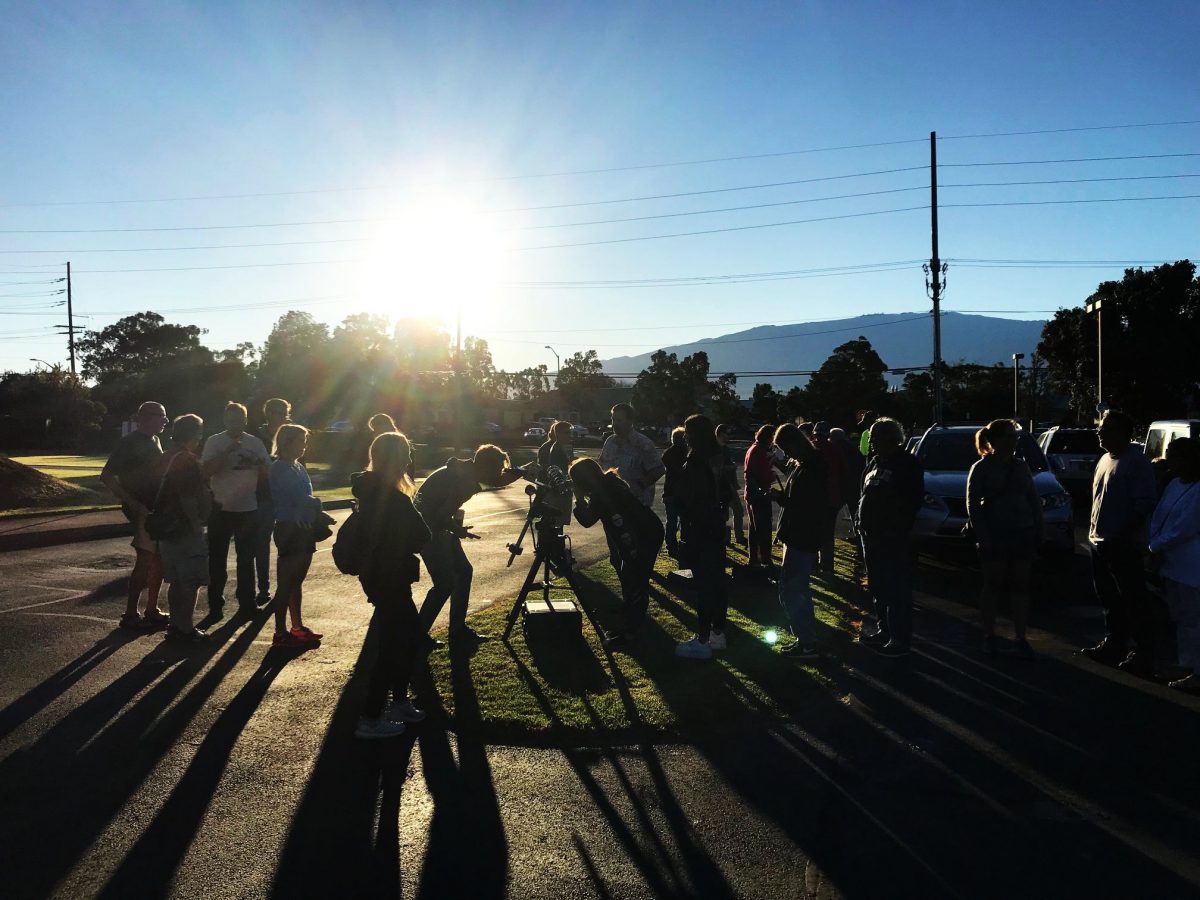
Transit Viewing

When you want to see the stars, find someplace dark

It was a clear predawn sky that greeted Waimea this morning, perfect to watch the transit of Mercury across the Sun.
An alarm set for o-dark-thirty and a drive to Waimea with the first glow of dawn behind the mauna. I did not have to pack a ‘scope as I would be using an observatory outreach telescope, just make sure I have camera gear ready.
Realistically I was expecting only a few folks in addition to the club members I knew were coming. A light crowd maybe? Thus I was rather surprised to find the parking lot filling quickly and our big conference room buzzing at 6am.
It was quite the crowd considering the Sun had not yet appeared over the shoulder of the mauna!
Continue reading “Mercury Transit 2019”Tomorrow morning, November 11th, there is a transit of Mercury. For observers here in the islands the event will be in progress when the sun rises, only the last hour and a half of the even visible.
You can read a full post with all of the event details here.
This is the last transit of Mercury until 2032, you might want to get out to see this one.
On November 11th, 2019 Mercury will transit the Sun. While transits of Mercury are not rare, they are not all that common either. The last transit was a few years ago in May of 2016. On average there are fourteen transits of Mercury each century or one every seven years. If you wish to observe one the situation is much better than transits of Venus which occur in pairs over a century apart.
This particular transit will favor observers in Europe, South America, and the eastern seaboard of North America where the entire transit will be visible. Unfortunately for observers in the islands only the final hour and a half of the transit will be visible having begun well before local dawn. Sunrise will occur around 06:28 for the island of Hawaiʻi, with the transit ending at 08:04 in the morning when the Sun will be 20° above the horizon.
Continue reading “Transit of Mercury Nov 11, 2019”As I gazed up at a nearly full Moon this evening I realized that the countdown is quite short now. When that Moon is new again it will pass in front of the Sun to create a total solar eclipse.

I have been anticipating and planning this trip for many years. It was after the transit of Venus in 2012 that I really turned my attention to the next major astro-event. Laying out plans to camp somewhere in Eastern Oregon where the viewing is likely to be excellent.
It was a beautiful morning! Alarm set for 4:30am, out of the house at 5am, setup just at sunrise on the old Saddle Road. The sun rose through low clouds over the grasslands of Parker Ranch with Waimea to one side and Mauna Kea on the other.

The seeing was pretty horrible at sunrise but rapidly improved as the Sun rose. As the transit ended the seeing was quite sharp and the photos not all that bad. At least as long as I kept the shutter speeds high. Visually the view was quite nice, a sharp black dot against the Sun, a far cry from the dancing blur you usually see when trying to view Mercury in the glow of Sunset.
Just a quick reminder that mercury will transit the face of the Sun tomorrow morning. You can read full details in my earlier post or check out a decent transit calculator. For observer in Hawaii the transit will already be well underway at sunrise, making this a set-the-alarm-early exercise. My telescope and solar filter are already loaded… Are yours?
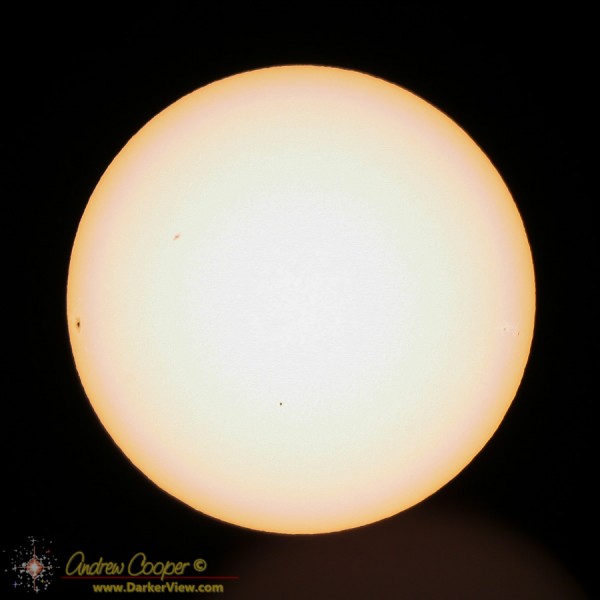
Both of the planets that orbit closer to the Sun, Mercury and Venus, can be seen to cross the face of the Sun if everything lines up just right. The last transit of Venus was in 2012. It has been much longer since a transit of Mercury, that last occurred in 2006.
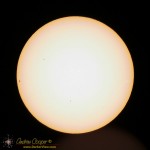
In comparison the the rare transits of Venus, transits of Mercury are fairly common. There are 13 or 14 transits of Mercury each century, meaning there is a transit on average every seven years. On May 9th this year we have another chance to observe a Mercury Transit.
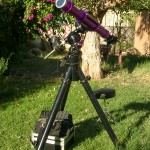
Mercury is quite small with respect to the Sun. During the transit the planet will be a mere 12-13 arcsec across. Considering the Sun is about 1920 arcsec across, the planet will be a fairly small dot on the face of the Sun.
In some respects a transit is the clearest view of Mercury small telescope users are able to view. Normally observed low on the horizon, the innermost planet never gets far from the Sun. During transit a fairly sharp disk can be seen, far better then the mushy view offered near the horizon at sunset and dawn.
| First Contact | 11:12 UT | 1:12 HST |
| Second Contact | 11:15 UT | 1:15 HST |
| Mid-Transit | 14:57 UT | 4:57 HST |
| Third Contact | 18:39 UT | 8:39 HST |
| Last Contact | 18:42 UT | 8:42 HST |
Please exercise caution when viewing the Sun! Use appropriate eye protection or indirect observing techniques to project an image of the Sun. The link at the start of this paragraph leads to a great discussion on viewing the Sun safely. As always the single best source on the web (or anywhere) for eclipse and transit information is Fred Espenak’s eclipse website at NASA. Stop by whenever you have a question on upcoming events as well as viewing and photography tips.
The next Mercury transit will occur November 11, 2019. This next transit also favors Europe as mid transit occurs at 15:20UT. For the next Venus transit? You are out of luck as it occurs in 2117, over a century away.
Almost a week later and the comments keep coming in… E-mails to the observatory, comments on my blog, people are still pulling me aside to offer their comments in person. It is somewhat overwhelming. Did we really manage to do this?
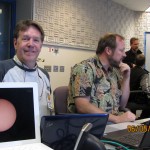
I spent 6 and change hours with you guys and I really appreciated your dedication to keeping everything up and running for us all around the world. HATS OFF YOU YOU ALL! – Kyle
We are in currently rainy Western Australia, and your webcast was the only way that we got to see the transit at all. My kids’ primary school all tuned into you at some point during the day. 🙂 – Carina
I have been reading the comments as they come in. It is truly gratifying that we managed to share this unique event with so many people.
You made my wife’s day! She was stuck at work & had you and the Keck team in the background for the entire transit! She is eternally grateful! Mahalo nui loa! – Joel
I watched your webcast of the transit from start to finish (with a few breaks here and there). What a great job you guys did! Fascinating, funny and I learned a lot in the process. Thank you for your efforts, and I too look forward to other webcasts from Keck. – Carol
I do not expect we will be doing this again right away. It takes the right sort of event. The one previous webcast was during the close approach of the asteroid 2005 YU55 in November of 2011. That time we webcast from the remote operations room in Waimea. It was also a good success, with great cooperation from the astronomers doing the observation. Need to take advantage of the best opportunities.
Thank you all for your hard work and dedication. I signed on t minus 10 min and stayed until you guys went off the air. I enjoyed myself the entire time. I know for a fact that a lot of people learned tons during this broadcast. My wish, hope and dream is that you continue to do events like this. You all gave it such a warm (beep) behind the scenes feel that made us all feel “part of the science.” The picture in picture was awesome and the graphics support mid-show was much appreciated. I can’t wait until next time! – Eric
We supported an average of between 5k and 6k viewers at any given time, with a total of over 100,000 live views. This viewer count may have badly underestimated the actual number of viewers, often the feed was being shown to large crowds at other public venues. Andrea Ghez mentioned that they were showing our feed at the UCLA event, the feed was on at at least two schools, and our own crowded Hualalai auditorium at Keck Headquarters in Waimea. I keep learning of other crowds the feed was shown to…
“Our observatory in Sonoma County was clouded out much of the day so we had your feed up for our 300+ visitors to supplement live viewing between the clouds. After sunset I went home to watch the rest of the transit on UStream and read the firehose of comments. It was a giant star party! Thanks for all the effort. Best outreach ever!” – Cecelia
A great experience shared with so many people across the globe. Thanks to everyone who made the Transit of Venus such a great day… Our Keck crew and the viewers who were there with us.
We did the Transit of Venus right.
The plan was to stream the transit live from the summit. With access to the Keck facilities we had internet, a comfortable break room, and an excellent vantage point from which to view the entire transit. It sounded so easy at first, just put a camera on a telescope and connect it to the computer for the duration. Easy, in concept. The reality? Not so much.
It was an incredible amount of work. I had spent several days during the preceding weeks preparing the gear for transit. I admit some of that was fun, an excuse to get the gear out in the day and look at the Sun, even photograph Venus quite near the Sun.
The webcast team consisted of three people, Larry O’Hanlon, the Keck PIO, Mark Senft, a volunteer from our astronomy club, and myself. Larry and I met a HQ to begin our drive up the mountain at 8am.
At Hale Pohaku we picked up Mark and enjoyed breakfast. Here we found a massive buildup in progress, a gathering of troops… Visitor center staff, Hawai’i County police and fire, and the Mauna Kea Rangers, all present in force. Stephanie Nagata, the director of the Office of Mauna Kea Management helped man the roadblock. Stewart Hunter, the head of Mauna Kea Support Services with her in an orange vest. Their preparations looked to be necessary, three hours prior to first contact the crowds of transit tourists were already growing.
Continue reading “The Transit of Venus”